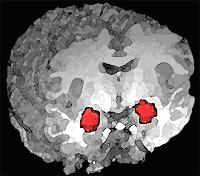
I'm trying to think of a tech analogy - something to do with software - it's like writing a new program, only the thing teaches itself, like with artificial intelligence. In other words, it learns from its environment, and is continually adapting to new information.
The difference is that with a child, many of the emotional/relational imprints are stored as raw impressions rather than as logical constructs, so that eradicating and/or undoing them once they've been imprinted is rather like trying to cancel out an image that's been stamped into a piece of metal (embossing, I think that's called - ooh, feel some convoluted connection trying to get my attention, but will ignore the temptation to derail for now).
Or like I've probably said before, the blank cassette tape analogy where the old recording leaks through into the current 'data' (can't think of the right word).
As I understand it (layperson here), the amygdala*

stores these impressions almost like a single frame of a movie, complete with all the sensory data that was perceived at the time, a snapshot: Sound (loud? confusing?) , color, light (flashing? bright, overwhelming? dim, foggy?), smells (ever connect a smell to something unpleasant without knowing why?), touch. The whole works is there, the complete package.
It's a way for our pattern-matching intelligence to create a pattern to which to match future inputs: Like a series of slides that the mind (is that the right word?) instantly sorts through at a subconscious level to see if the current 'input' signifies 'danger' or 'not danger'.
It seems to be very much a binary, very much an on/off, black/white, either/or, highly simplistic lizard-brain kind of thing. I think I've said this elsewhere already, but my impression (from observation of self and others as well as reading on the subject) is that there ain't a whole lot we can do about it.
We can try to become aware, but mainly this is in a janitor-with-a-mop after-the-fact kind of way. Messes happen because our really smart, really fast, prehistoric brain that kept us alive through all kinds of split-second decisions dealing with hazards that our conscious brains would've been way too slow for, is now using that split-second reaction behavior in situations for which it's often completely unsuited.
And the fact is, we ain't evolved much since then. Evolution takes place on an epochal scale, and the amount of time that's passed since we moved out of the trees into condos hasn't been long enough to significantly rewire our basic hardware.
So even though we may live in the concrete jungle, our equipment operates as if we're still swinging from branches, expecting something slithery with fangs on the end to drop on our heads at any moment.
How to deal with this? As always, it seems that awareness is the best we can do (something niggling about Eve and the apple, and the apple representing self-awareness as the serpent that ruined the Garden, that changed us forever from being contented, non self-aware animals like all the others into neurotic, self-reflective worriers who are continually trying to sort right from wrong. Subject for another post.)
*From the biopsychiatry.com link:
The amygdala, an almond-sized and -shaped brain structure, has long been linked with a person's mental and emotional state. But thanks to scientific advances, researchers have recently grasped how important this 1-inch-long structure really is. Associated with a range of mental conditions from normalcy to depression to even autism[...]Derived from the Greek for almond, the amygdala sits in the brain's medial temporal lobe, a few inches from either ear. Coursing through the amygdala are nerves connecting it to a number of important brain centers, including the neocortex and visual cortex.
From serendip.brynmawr.edu:
From the evolutionary standpoint, the theory is that fear is a neural circuit that has been designed to keep the organism alive in dangerous situations. How does it all work? Learning and responding to stimuli that warn of danger involves neural pathways that send information about the outside world to the amygdala, which in turn, determines the significance of the stimulus and triggers emotional responses like freezing or fleeing as well as changes in the inner workings of the body's organs and glands. There are important distinctions to make between emotions and feelings. Feelings are "red herrings", products of the conscious mind, labels given to unconscious emotions. But the components of fear goes beyond feelings and emotions. It is also the specific memory of the emotion. After a frightful experience, one can remember the logical reasons for the experience (e.g. the time and place) but one will also "feel" the memory, and his body will react as such (i.e. increased heart and respiration rate, sweating). In one recent case, after a near drowining incident, the victim could not only vividly remember each detail, but when doing so, his body reacted as though he were reliving the experience. These feelings of memory are stored in an almond shaped structure in the brain known as the amygdala. [bold mine.]

No comments:
Post a Comment